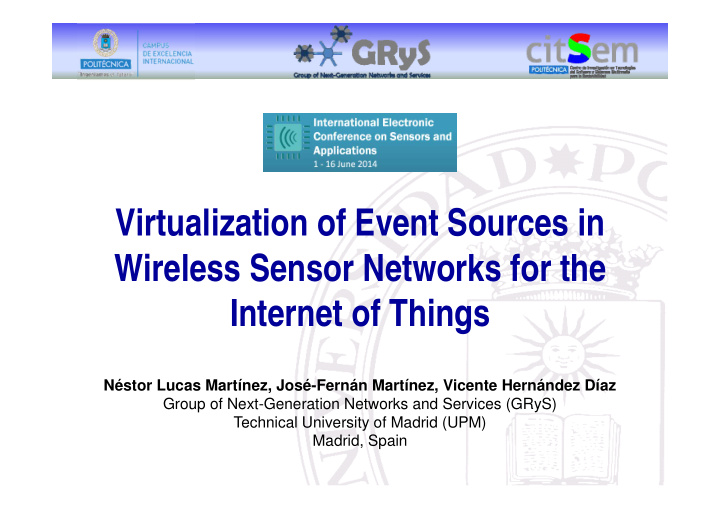



Virtualization of Event Sources in Wireless Sensor Networks for the Internet of Things Néstor Lucas Martínez, José-Fernán Martínez, Vicente Hernández Díaz Group of Next-Generation Networks and Services (GRyS) Technical University of Madrid (UPM) Madrid, Spain
Summary • Introduction • Virtualization model • Test scenario • Conclusions • Outlook • Acknowledgements 1
Introduction • Event-driven systems are commonly part of our daily lifes and must be integrated in IoT. • They have to be virtualized complying with IoT reference models: • Event-driven parts (events, event sources, subscribers) have to be virtualized by means of system resources. • A REST compliant model for event-driven systems has to be accomplished. 2
Virtualization model • Nodes in a WSN can be represented by the resources they provide. • Nodes that detect or generate events are identified as event sources in the WSN. • The events detected or generated by event sources are their resources. • A gateway is used to provide Internet connectivity to the nodes in the WSN. • Resources from the nodes can be replicated in the gateway, as virtual representation of them. 3
Virtualization model. First step. Event sources are identified by their resources, the events, and represented in the gateway as virtualized event sources. 4
Virtualization model. Second step. Users, considered as event consumers, subscribe themselves to the event sources registered in the event manager though the virtualized event source. 5
Virtualization model. Third step. Events notified by the event sources are then propagated to the event consumers through the event manager in the gateway. 6
Test scenario The model has been tested in the scope of the European project “Web of Objects” (WoO), in a real scenario based in an open smart neighborhood. 7
Test scenario The sensor nodes used in the scenario are SunSPOT devices manufactured by Oracle Corporation. Two nodes were configured as event sources: • A fire detector based on heat. • A presence detector. These two nodes were deployed among other active sensor nodes. 8
Test scenario The gateway was PC running Ubuntu 12.04 LTS, connected to a SunSPOT base station which provides IEEE 802.15.4 connectivity with the nodes in the WSN. The required components to virtualize the event sources from the WSN were developed as bundles deployed on an Enterprise Service Bus. 9
Test scenario Regarding the event source virtualization, the following results were obtained: • Every event source were correctly identified by the gateway. • Every event source identified were represented by its virtual counterpart exposing the events as resources. • Every event notified by an event source were correctly captured by the event manager, and delivered to the event subscribers. • The event notification takes a small fraction of the time specified in the functional requirements of WoO. 10
Conclusions • The model described in previous slides has been successfully implemented and tested in a real IoT scenario. • The UPM REST model for event-driven systems was readily integrated with other partners components, achieving expected improvements and objectives. • Event sources were semantically described in a repository, leveraging interoperability of different solutions. 11
Outlook • Virtual event sources by composing events from other event sources. An orchestrator in a WSN node: • Will look up for specific event sources in the network. • Will subscribe to event sources notifications. • Will publish itself as an event source. • Will accept subscribers. • Will notify subscribers when a sequence of events from other event sources follows. 12
Acknowledgements This work is supported by the European project “Web of Objects” labelled by the European research program ITEA2 (project code ITEA2-10028) and the Spanish “ Ministerio de Industria, Energía y Turismo ” (project code TSI-020400-2011-29). 13
Recommend
More recommend